Cooking
Spices and Herbs used in Mangalorean Cookery.
|
Spices and Herbs used in Mangalorean Cookery.
Red chilies are used in the preparation of spice pastes/ masalas in Mangalorean cookery. There are 4 different varieties used most commonly in Mangalorean dishes.
|
|
 |
Byadagi or Kaddi Chillies-Byadagi chilies are grown in Goa and Dharwar in Karnataka. The thin, tall crinkly Chilli gets its name from a small town Byadgi, located near Haveri district of Karnataka, a state located in the South of India. These chillies are also called Kaddi ( (Kaddi = Thin and slender in Kannada) ) chillies and when dried, the skin is wrinkled red in color with aromatic mild pungency. They provide a distictive red color and flavour to Mangalorean food |
 |
Kashmiri Chillies-One of much in demand chilli in India is Kashmiri Chilli. Though there is lot of wrong claims, the true Kashmir Chilli is grown in Himachal Pradesh and Jammu and Kashmir. It has a crinkled shiny skin and is fleshy with a dark red in color. They are mild in pungency and have a fruit like flavor.
|
 |
Guddi Mirsaang /Chilli-Very strong, spicy, non crinkly short chilli which gives a rich red color.
|
 |
Jirgi Mirsang Chilli– These are tiny chillies that are very hot and pungent.
|
  |
Kashmiri Chili powder (Mirsang pito)-Red color, fine powder. It is mildly hot and renders spice pastes a rich red colour.
Cayenne pepper (Lal Mirch)-is a spice made from the seeds of plants in the capsicum family (ranging from sweet pepper to chili – in general, the smaller the fruit, the hotter it is). Cayenne peppers’ bright red color signals its high content of beta-carotene or pro-vitamin A. It includes both the ground seeds as well as the dried flesh. It should not be as hot as chili powder, but it is pretty hot and should therefore be used with care. Cayenne pepper is used to provide the heat for many spicy dishes.
|
|
Asafoetida (Hing) – also known as devil’s dung. It is a resin taken from a plant from the parsley family. It is a distinctive and pungent spice. It is most commonly found in powdered form. When cooked, it has a truffle-like flavor and a roasted garlic aroma. It is used mainly for its digestive properties, especially in the cooking of beans and lentils, as it is reputed to have antiflatulence properties. A pinch of it can be fried in hot oil before the rest of the ingredients are cooked.
|
|
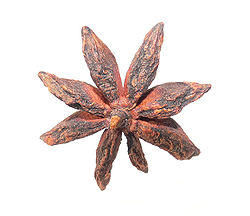 |
Star Anise– its star shape and a licorice taste similar to regular anise, only stronger. Star anise is the seed pod of an evergreen tree
|
 |
Turmeric root– comes from the root of Curcuma longa, a leafy plant related to ginger. It has a bright yellow color and a pungent, warm, earthy aroma and taste. Although it becomes bitter if too much used. It is mildly antiseptic.
|
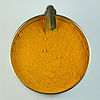 |
Turmeric powder (Hallad)- Turmeric is an essential spice in Indian food, giving a rich, appetizing color. It is used in curries, fish dishes and with beans because of its digestive properties. Research show that turmeric inhibits blood clotting, reduces liver toxins, and helps the liver metabolize fats and so aids weight loss.
|
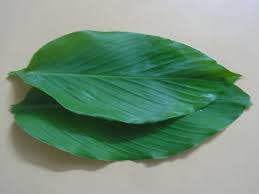 |
Turmeric leaves- Used to prepare sweets called patholoyos, also for baking fish.
|
 |
Tamarind (Amsan) –It is the sticky, dried, brown pod of the evergreen tree. It has a sour taste and very tart, citric flavor. The pulp must be soaked before usage. It is used as a souring agent in curries, pickles, chutneys of meat , fish and vegetables.
|
 |
Peppercorns (Meere) – available in two varities black and white. It is very pungent. It is used in its whole and powdered form in various forms of cooking. Black pepper is more aromatic, white is stronger and hotter. Pepper is the only spice that us used to flavor food before, during and after cooking. Whole or grounded peppercorns can be added to most non-sweet dishes.
|
 |
Nigella/ Onion Seeds (Kalonji) – are small, irregular shaped black seeds of the plant that grows in India – Kalonji. This spice can be used fresh or dry roasted in curries, and added to vegetables, relishes, pickles and yogurts. It is featured in many spice mixtures such as Bengali five-spice mixture panchphoron, which also includes fenugreek, mustard, cumin and fennel.
|
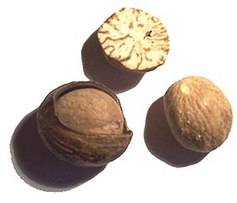 |
Nutmeg (Jaiphal)- The nutmeg fruit contains an outer covering called mace and an inner fruit which is the nutmeg. It has nutty, warm and slightly sweet flavor. Nutmeg is used to add sweet and savory flavor to dishes such as pies, custards, puddings, cakes, soufflés, vegetables, egg dishes, lamb, and fish, and beverages.
|
 |
Mace (Javitri)- is the fleshy lattice, covering of the nutmeg (hard nut), which is golden brown in color. Like nutmeg, mace is a sweet and flavorful spice, which can be substituted for nutmeg or cinnamon to complement a variety of foods. Mace is also used in sauces for fish and pickle chutneys.
|
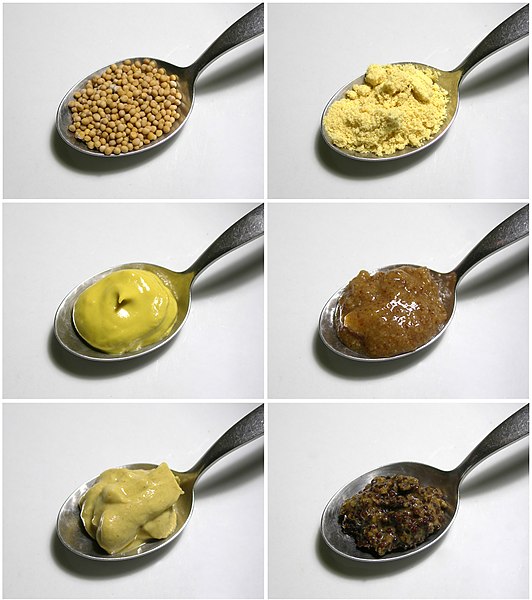 |
Mustard– The brown mustard seeds are more commonly used in Indian cooking but black seeds contain a higher proportion of the volatile mustard oil and strongest flavor. The larger yellow variety, known as white mustard are much les pungent. Powdered mustard has no aroma when dry, but a hot flavor is released when it is mixed with water. The seeds can be put whole into very hot oil and popped. Mustards seeds are a popular addition to dishes such as vegetable, beans, pastries and pickles. Also available as a sauce and pastes.
|
 |
Mint (Pudina)-Indian mint has a stronger flavor and more pungent aroma than Western varieties. This herb is often paired with lamb. The warm sweet fragrance of mint is cooling to the palate, leaving a fresh aftertaste. Indian cooking and is widely used in chutneys, relishes, salads, sauces and teas. Mint is mostly added to biryanis. Mint is also perfect as a garnish for desserts, and goes well with fruits, iced tea, lemonade and yogurts as well as a variety of cocktails.
|
 |
Mango powder (Amchur)- This sour powder is made from unripe mangoes. It has a sour, lemony taste, with a slightly sweet edge. The primary use of it is for Chutneys. It can be added to chickpeas, potatoes and eggplants. More, it is used as a dry seasoning for grilled dishes and sometimes appears in Bombay mix, the Indian version of potato chips or pretzels. Amchur is also an essential ingredient in making Chaat Masala. It gives any dish a tangy, sour flavor, and is the perfect substitute for lemon, tamarind or lime juice. If you are unable to find you can use a dash of lemon.
|
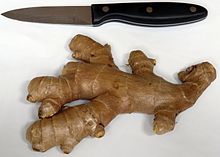 |
Ginger (Alae)– the fresh root is a knobly rhizome with a sweet aroma and hot, pungent taste. It is used very commonly in Asian cooking. It is commonly combined with garlic and sold in a paste form. Young ginger is used to make ginger preserve. Also used in the preparation of pickles, syrup, ginger biscuits.
|
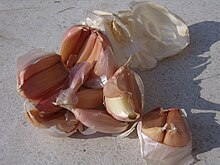 |
Garlic (Lasun) – closely related to the onion. It has a powerful pungent or hot flavor when raw, which mellows when it is cooked. It has very strong odor. Bulbs, whose segments are usually called “cloves” are the part of the plant most commonly eaten.Garlic is used as a condiment and as flavoring in gravies, sauces, soups, stews, pickles, salads, salad dressing and breads. Garlic pickles and freshly ground garlic chutneys are popular side dishes for rice, snacks and chappathis. Garlic powder is made from ground dehydrated cloves and is used widely as a substitute for fresh garlic. Garlic helps to purify the blood and lower blood pressure. It is considered as a cure for heart ailments.
|
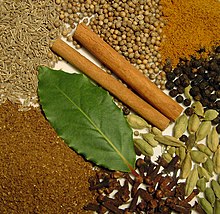 |
Garam Masala– meaning “hot spices” – is a mixture of ground spices (recipes vary) (cloves, cardamom, cumin, peppercorns and cinnamon, bay leaves). It is far better to grind your own spices than to buy the mixture ready-ground.
|
 |
Fenugreek (Kasuri Methi)– is short, upright plant (related to spinach) with oval leaves. The entire plant has a strong, sweet aroma. The mature leaves have the bitter taste. Ground fenugreek (seeds) has a warm, yellowish-brown color with a strong curry-like taste. In powdered form, fenugreek is one of the main ingredients of curry powders. Fenugreek is used to add flavor to meat dishes. It is also considered as an aphrodisiac.
|
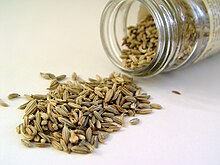 |
Fennel (Saunf)-It has a sweet and aniseed flavor.Used sparingly, it gives warmth and sweetness to curries. Sugar coated or roasted fennel seeds are chewed to freshen the breath after the meal. They have digestive properties.
|
 |
Curry leaves (Kadi patha) – are small grey-greenish leaves (a bit like bay), relative of the orange. They can be used fresh or dried. Their aroma is released by its heat and moisture. They are sometimes fried in the oil the food is cooked in, and then discarded. They are mainly used as an aromatic and flavoring for most curries and soups. Also used to make chutneys.
|
 |
Cumin (Jeera) –The seeds are oval with ridges, greenish-beige in color, warm, nutty aroma. They can be ground to a powder. Cumin is usually dry-fried before use. It is used in preparation of curries of meat , fish, vegetables. Also used as seasoning of pickles, chutneys, lentil soups/dhals.
|
|
Ajwain, Oma (vovam)- This spice contains thymol oil. It has medicinal properties, and its decoction is used to treat colds. The preparation Nivol is given to breastfeeding mothers when babies have a cold.
|
|
 |
Cloves (lavang)– It has a strong, sweet aroma and hot, pungent taste, Cloves are best bought whole and ground, if necessary. They have been used in India for thousands of years, not only in cooking, but to sweeten the breath and to relieve the pain of toothache. They contain a mild anesthetic. Whole cloves are frequently used to flavor meat dishes, curries, and soups.
|
 |
Cinnamon (Dalchni)– is the dried bark of various laurel trees in the cinnamomun family. It is a sweet-tasting spice, with a warm, woody aroma. The smell of Cinnamon is pleasant, stimulates the senses, yet calms the nerves.The thinnest bark is the best quality cinnamon. It is available as a powder but is much better bought in sticks. When ground, the flavor becomes stronger. Whole cinnamon is used for spacing hot drinks, ground- in cakes, sweet dishes, fruit pies (especially apples). It can also be used in more piquant dishes, such as curries, and combines perfectly with chicken.
|
 |
Coriander seeds (Dhaniya)– is a member of a parsley family. The seeds are oval in shape, ridged, and turn from bright green to beige when ripen. This spice tastes sweet and tangy, with a slightly citrus flavor. Coriander is usually sold in powdered form, although the whole seeds are also available. An important spice used in preparation of spice pastes/ masalas for meat, fish and vegetables curries.
|
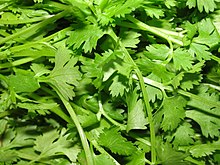 |
Cilantro (Hara Dhaniya/Kothmir Bhaji)– this fresh herb is a fragrant mix of parsley and citrus. The leaves are rather like those of flat-leaved parsley, but darker. The leaves have a very distinctive bitter-sweet taste. Cilantro it is usually added toward the end of cooking to preserve the fresh aroma. Also it is frequently used as a garnish. The seed of the cilantro is known as coriander.
|
 |
Cardamom (Elaichi)-Elettaria Cardamomum is the seed of a tropical fruit in the ginger family.Fruits and seeds leave pleasant aroma with sweet, pungent taste behind when chewed. Cardamom has a sweet, lemony, eucalyptus flavor. It is world’s second most expensive spice. It is available as a powder, dried pods, or loose seeds. Green cardamoms are the most common, but there are also black and cream varieties. It is one of India’s favorite spices, used in curries, savoury and sweet dishes, ice cream and custards.
|
 |
Kokam has the same souring qualities as tamarind, especially enhancing coconut-based curries or vegetable dishes like potatoes, okra or lentils. Kokum is especially used with fish curries, three or four skins being enough to season an average dish. It is also included in chutneys and pickles.
|
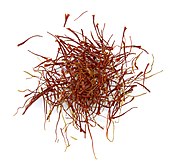 |
Saffron (Zaffran)- this spice is made from orange colored dried stigmas of the especially cultivated crocus (75 stamens are needed to make 100 g (4 oz) of the spice.) It is the most expensive spice of all. It has a distinctively pungent, honey-like flavor and aroma. It is available as whole threads or powdered. When ground they form a russet powder. The filaments can be lightly roasted, crumbled in a little hot water and left to infuse to bring out their full strength. Saffron is used to color rice dishes, sweets, puddings, sauces and soups to bright yellow.
|
 |
Bayleaves- these fragrant leaves with pointed ends are used in their dried form. These are used in curries and rice preparations.
|
